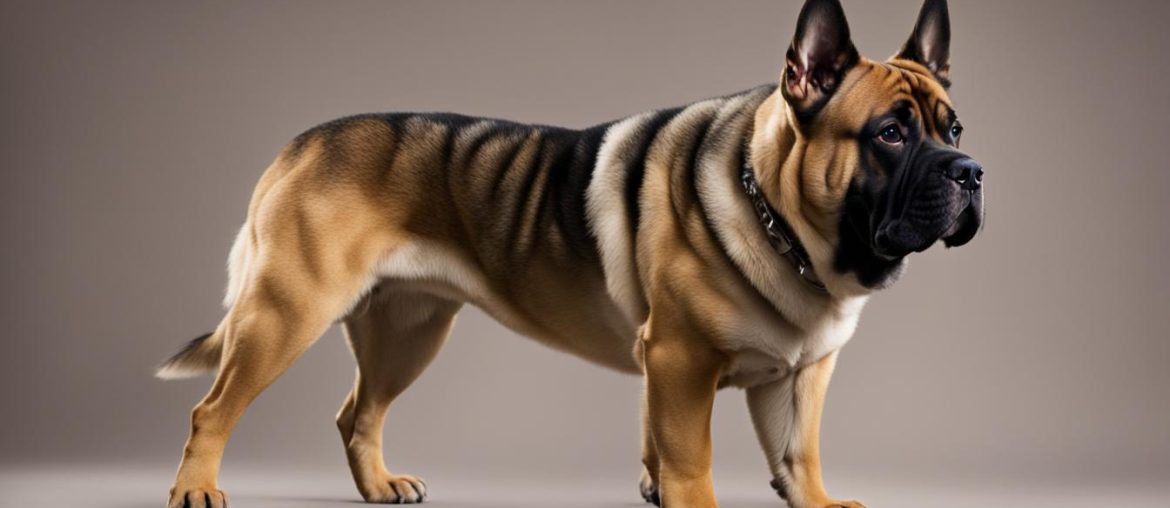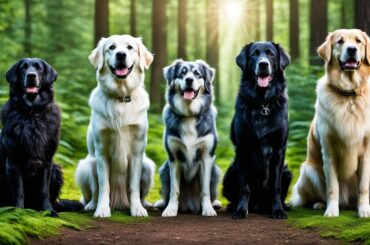If you’re considering adding a furry friend to your family, it’s important to take into account the potential costs associated with owning a dog. While all dogs require love, care, and financial investment, some breeds come with a higher price tag than others. In this article, I will introduce you to the most expensive dog breeds in the United States, providing insights into their characteristics and potential health issues. By understanding the costs and considerations associated with these high-priced dog breeds, you can make an informed decision when choosing your canine companion.
Key Takeaways:
- The cost of owning a dog can vary depending on the breed.
- Purebred dogs are generally more expensive than mixed breeds.
- Health issues specific to certain breeds can result in higher vet bills.
- Consider your budget and lifestyle when choosing a high-priced dog breed.
- Remember that the initial purchase price is just the beginning of the financial commitment.
Afghan Hound
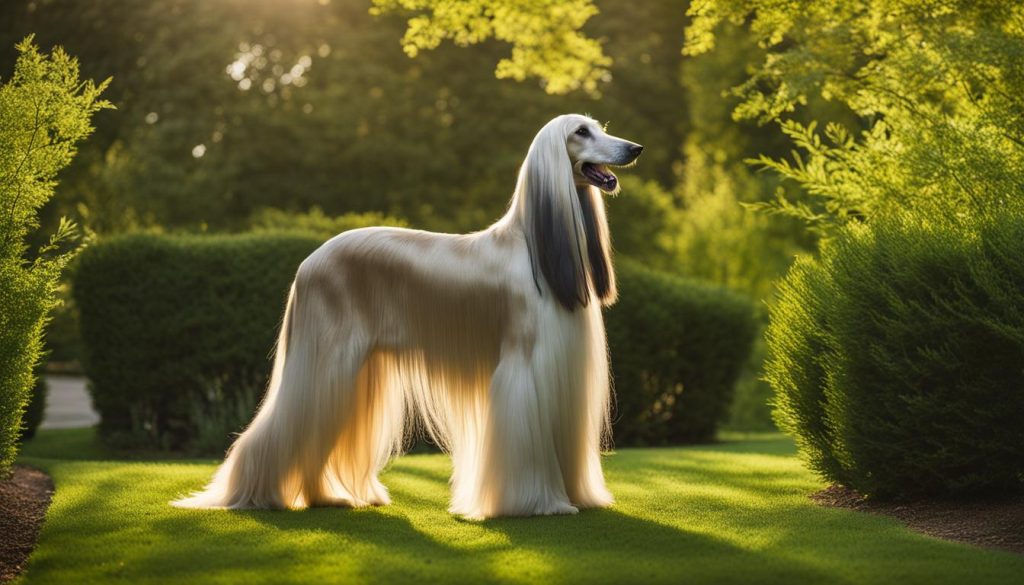
The Afghan Hound is a majestic breed known for its long, silky coats and graceful appearance. These dogs are often considered some of the most beautiful in the world, with their flowing locks and regal stance. They require regular grooming and daily hair brushing to prevent matting and keep their coats in pristine condition. The Afghan Hound’s stunning appearance and unique features make it a popular choice among dog enthusiasts and show dog competitors.
Aside from their striking looks, Afghan Hounds have a lifespan of 10-14 years, on average. However, like any breed, they can be prone to certain health issues that may require veterinary attention. Cataracts, a condition that clouds the lenses of their eyes, can affect Afghan Hounds, leading to impaired vision and potential treatment costs. Additionally, hypothyroidism, a condition where the thyroid gland does not produce enough hormones, is also common in this breed and may require ongoing medication or management.
The Afghan Hound’s beauty is truly mesmerizing. Their flowing coats and unique appearance make them stand out wherever they go. However, it’s important to remember that maintaining their long silky coats requires regular grooming and care.
Despite their high maintenance needs, Afghan Hounds make excellent companions for those who appreciate their elegance and gentle nature. While they may require some extra effort in terms of grooming and potential healthcare, their stunning looks and regal presence make it all worth it for many dog owners.
Table: Health Issues in Afghan Hounds
| Health Issue | Description |
|---|---|
| Cataracts | Clouding of the lenses of the eyes, leading to impaired vision. |
| Hypothyroidism | Inadequate production of thyroid hormones, which can affect metabolism and overall health. |
Pharaoh Hound: The Loyal Hunters
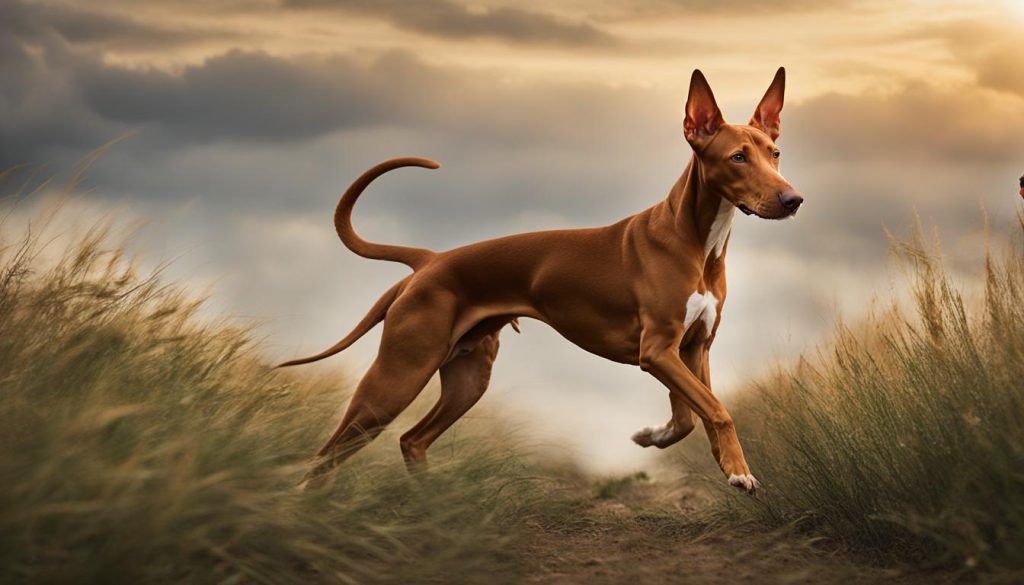
The Pharaoh Hound is a breed known for its exceptional hunting abilities and unwavering loyalty to its owners. With their unique appearance and rich history, these dogs have captured the hearts of many dog enthusiasts. Originally from Malta, the Pharaoh Hound is believed to be one of the oldest domesticated dog breeds, dating back over 5,000 years.
“The Pharaoh Hound is a true hunter at heart, with a keen sense of smell and incredible speed,” says Sarah Johnson, a renowned dog trainer. “Their loyalty and dedication to their families make them exceptional companions.”
These sleek and muscular dogs are built for agility and endurance, allowing them to excel in various hunting tasks. Their impressive speed enables them to chase down prey with ease, while their acute sense of smell helps track scents over long distances. Whether it’s rabbits, birds, or small game, the Pharaoh Hound is always up for the challenge.
Aside from their hunting prowess, Pharaoh Hounds are also loving and affectionate pets. They form strong bonds with their families, showering them with unconditional love and devotion. Their friendly and playful nature makes them great companions for both adults and children.
| Traits | Description |
|---|---|
| Temperament | Loyal, intelligent, and affectionate |
| Size | Medium-sized, typically weighing between 45-55 pounds |
| Lifespan | Average lifespan of 11-14 years |
| Health Concerns | Prone to stress-related digestive and neurotic issues |
The Pharaoh Hound may require an experienced owner due to their independent nature. Early socialization and consistent training are essential in ensuring that they become well-rounded and obedient companions. Daily exercise and mental stimulation are also important for this active and intelligent breed.
While the Pharaoh Hound is generally a healthy breed, they can be sensitive to stress, which can lead to health issues. It’s crucial for owners to provide a calm and structured environment to help keep these dogs happy and healthy. Regular vet check-ups and a nutritious diet are also key in maintaining their overall well-being.
The Unique Appearance of the Pharaoh Hound
One of the standout features of the Pharaoh Hound is its graceful and elegant appearance. They have a sleek, muscular body with a long, lean neck and deep chest. Their short and glossy coat comes in various shades, ranging from tan to chestnut. The most striking feature is their expressive almond-shaped eyes, which are usually amber or golden in color.
To summarize, the Pharaoh Hound is a remarkable breed that combines hunting prowess with unwavering loyalty. Their unique appearance and charming personality make them a popular choice for dog lovers around the world. However, potential owners should be prepared to provide the necessary training, exercise, and care to ensure a happy and healthy life for their Pharaoh Hound.
Dogo Argentino
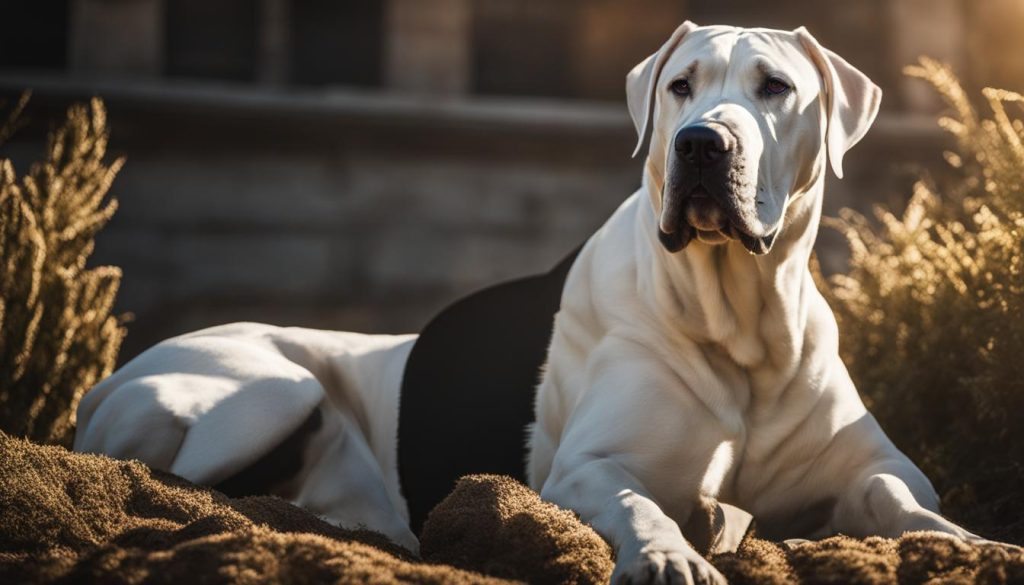
One of the most remarkable and fascinating dog breeds in the world is the Dogo Argentino. Known for its big-game hunting abilities and muscular stature, this breed has captured the attention of dog enthusiasts worldwide.
The Dogo Argentino was originally developed in Argentina by Antonio Nores Martinez in the early 20th century. Its primary purpose was to create a breed capable of hunting large game, such as boars and pumas. With its strong build, courageous nature, and incredible power, the Dogo Argentino quickly gained popularity among hunters and dog lovers.
This breed has a distinct appearance characterized by its solid white coat, muscular body, and large, expressive eyes. The Dogo Argentino embodies strength and agility, making it an ideal companion for those involved in activities such as search and rescue, tracking, and protection work. However, due to its size and strength, this breed requires early socialization, obedience training, and consistent exercise to ensure a well-balanced and obedient pet.
| Characteristics | Details |
|---|---|
| Size | Large |
| Weight | 80-100 pounds (male), 70-90 pounds (female) |
| Height | 24-27 inches (male), 23-26 inches (female) |
| Life Expectancy | 12-14 years |
| Health Issues | Hip dysplasia, deafness |
With its impressive physical attributes and loyal temperament, the Dogo Argentino is a breed that demands respect and admiration. Its agility, strength, and versatility make it an exceptional working dog and a beloved family companion.
Rare and Endangered: The Canadian Eskimo Dog

The Canadian Eskimo Dog is a rare breed that is on the brink of extinction. With less than 300 dogs remaining, it is crucial to raise awareness about their plight and the importance of preserving this unique breed. Originally brought to North America from Siberia, the Canadian Eskimo Dog has faced a decrease in numbers due to various factors.
This majestic and powerful breed is known for its ability to thrive in harsh Arctic conditions. However, its genetic diversity has been significantly reduced over time, leading to health issues that further threaten its survival. Canadian Eskimo Dogs are prone to gastric torsion, entropion, heat intolerance, and arthritis, which require specialized care and attention.
“The Canadian Eskimo Dog is a living testament to the resilience and adaptability of Arctic breeds. It is our responsibility to ensure their survival for future generations.”
Due to their rarity and unique characteristics, Canadian Eskimo Dogs may not be suitable for every family. They require experienced owners who have the resources and commitment to provide for their specific needs. Considering the potential health issues and the limited number of dogs remaining, owning a Canadian Eskimo Dog is a significant responsibility.
Table: Health Issues of Canadian Eskimo Dog
| Health Issue | Description |
|---|---|
| Gastric Torsion | A life-threatening condition where the stomach becomes twisted, leading to bloating and potential organ damage. |
| Entropion | An eyelid abnormality where the eyelid rolls inward, causing irritation and potential corneal damage. |
| Heat Intolerance | Canadian Eskimo Dogs have a thick double coat that makes them susceptible to overheating in warmer climates. |
| Arthritis | Joint inflammation and pain that can affect the mobility and quality of life of Canadian Eskimo Dogs. |
With concerted efforts and proper conservation strategies, we can help prevent the extinction of the Canadian Eskimo Dog. Preserving this rare breed is not only crucial for our collective heritage but also for the unique qualities and characteristics they bring to the world of dogs.
Rottweiler

The Rottweiler is a common breed of dog known for its strength, loyalty, and protective nature. They are often used as working dogs, excelling in roles such as search and rescue, police work, and service animals. However, along with their popularity comes some potential health issues that can result in high pet insurance claims.
One of the main health concerns for Rottweilers is hip dysplasia, a condition where the hip joints do not develop properly. This can cause pain, lameness, and difficulty walking. It is recommended to have Rottweilers screened for hip dysplasia and to consider pet insurance that covers the cost of treatment if needed.
Rottweilers are also prone to other health issues such as elbow dysplasia, aortic stenosis (a heart condition), and certain types of cancer. These conditions can result in expensive vet bills, especially when combined with the breed’s size and weight.
To ensure the health and well-being of a Rottweiler, it is important to provide regular exercise, a balanced diet, and routine veterinary care. Additionally, pet insurance can help to mitigate the financial burden of potential health issues. By being aware of the breed’s common health concerns and taking proactive measures, Rottweiler owners can provide the best care for their beloved pets.
| Common Health Issues for Rottweilers | Average Cost of Treatment |
|---|---|
| Hip Dysplasia | $1,000 – $6,000 |
| Elbow Dysplasia | $1,000 – $3,000 |
| Aortic Stenosis | $2,000 – $5,000 |
| Cancer Treatment | $2,000 – $10,000 |
While Rottweilers are a common breed, it is important to be aware of the potential health issues they may face. By taking preventative measures, such as regular exercise, a healthy diet, and routine veterinary care, owners can help minimize the risk of health problems and potential high pet insurance claims.
Azawakh: The Newest Breed of Hunting Dogs
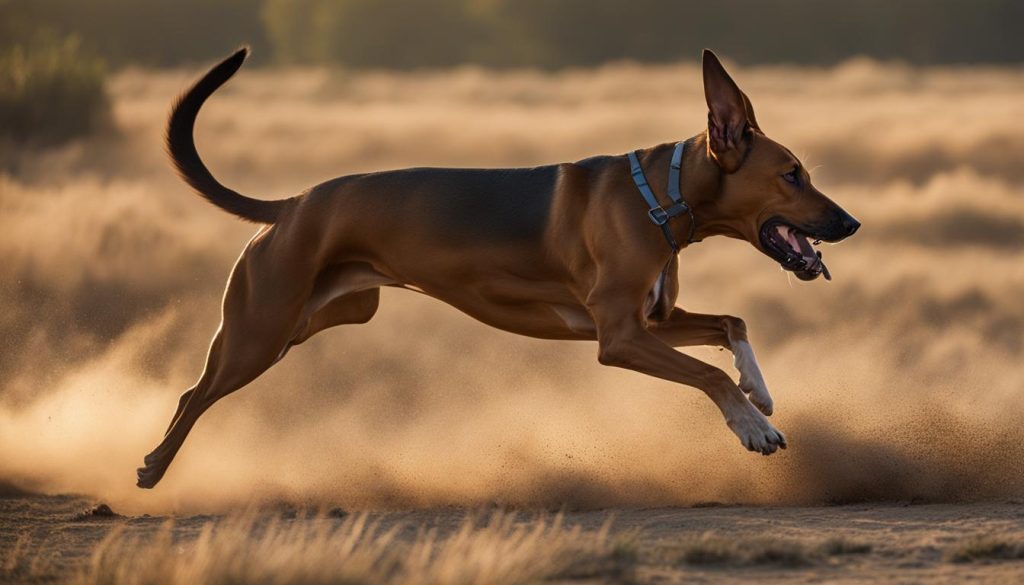
The Azawakh is a relatively new breed of hunting dog that hails from West Africa. Known for its elegance and grace, this breed is gaining popularity among dog enthusiasts. Azawakhs are intelligent, agile, and possess great speed, making them excellent hunters.
While the Azawakh is a healthy breed overall, there are a few hereditary conditions that potential owners should be aware of. Some Azawakhs may suffer from epilepsy, a neurological disorder that can cause seizures. Another condition to watch out for is Wobbler disease, a spinal disorder that affects the breed’s mobility.
Despite these potential health issues, the Azawakh has an average lifespan of 12 to 15 years with proper care and regular veterinary check-ups. This breed requires an active lifestyle and plenty of exercise to thrive, so it is best suited for individuals or families who can provide a stimulating environment for their canine companion.
| Characteristic | Description |
|---|---|
| Origin | West Africa |
| Size | Medium to large |
| Temperament | Intelligent, independent, and loyal |
| Exercise Needs | High |
| Lifespan | 12-15 years |
| Common Health Issues | Epilepsy, Wobbler disease |
The Azawakh is a breed that combines beauty and athleticism. With its slender build and high energy levels, it is perfect for individuals or families who enjoy an active lifestyle. However, prospective owners should be aware of the potential health issues associated with the breed and be prepared for the financial responsibilities that come with owning a dog.
Overall, the Azawakh is a fascinating addition to the world of dog breeds. Its unique appearance, hunting instincts, and loyal nature make it a sought-after companion for those who appreciate the beauty and athleticism of this remarkable breed.
Tibetan Mastiff
The Tibetan Mastiff is a massive dog breed that originates from Tibet. Known for its imposing size and powerful presence, this majestic guardian and protector is revered by many dog enthusiasts. With its thick double coat and distinctive appearance, the Tibetan Mastiff has become increasingly popular among dog lovers.
This regal breed is well-suited for guarding and protecting its family and territory. With a strong sense of loyalty and a natural instinct to guard, the Tibetan Mastiff is a reliable and vigilant companion. Its calm demeanor and protective nature make it an ideal choice for those seeking a devoted and trustworthy guardian.
While the Tibetan Mastiff’s imposing stature and protective instincts make it an exceptional companion, it’s important to consider the potential health issues associated with the breed. These can include hip dysplasia, hypothyroidism, and eye anomalies. Regular veterinary check-ups, proper diet, and exercise are essential in maintaining the overall health and well-being of this magnificent breed.
| Tibetan Mastiff Characteristics | Description |
|---|---|
| Size | Massive |
| Coat Type | Thick double coat |
| Temperament | Loyal, protective |
| Health Issues | Hip dysplasia, hypothyroidism, eye anomalies |
| Life Expectancy | 10-14 years |
When considering a Tibetan Mastiff, it is essential to provide the breed with ample space, exercise, and mental stimulation. This breed thrives in environments where it can fulfill its natural instincts and feel a sense of purpose. Additionally, proper socialization from an early age is crucial to ensure a well-rounded and balanced temperament.
Chow Chow – The Oldest and Rarest Breed with High Costs of Ownership
The Chow Chow is a distinctive breed known for its teddy bear-like appearance and unique blue-black tongue. With roots dating back thousands of years, it is considered one of the oldest and rarest breeds in the world. The Chow Chow’s regal and aloof nature, combined with its elegant and sturdy build, make it a highly sought-after breed among dog enthusiasts.
However, owning a Chow Chow comes with its fair share of expenses. From the initial purchase price to ongoing care and maintenance, the high costs of ownership can add up.
In the words of a Chow Chow owner: “The Chow Chow is truly a majestic breed, but it’s important to be prepared for the financial commitment. From grooming and veterinary care to quality nutrition, the expenses can quickly add up. But the love and companionship they provide make it all worthwhile.”
One of the main factors contributing to the high costs of owning a Chow Chow is their specific grooming needs. The breed’s dense double coat requires regular brushing and professional grooming to maintain its appearance and prevent matting. This can result in frequent visits to the groomer, which can be quite expensive.
Additionally, Chow Chows may be prone to certain health issues, including hip and elbow dysplasia, patellar luxation, and entropion. These conditions can require specialized veterinary care and ongoing treatment, leading to higher-than-average veterinary bills.
| Expenses | Average Cost (per year) |
|---|---|
| Grooming | $500 – $800 |
| Food | $800 – $1,200 |
| Vet Care | $500 – $1,000 |
It’s important to consider these factors and budget accordingly before welcoming a Chow Chow into your family. While they may be a prized possession, the financial commitment associated with this unique and ancient breed should not be taken lightly.
Löwchen: The Rare and Playful Little Lion Dog
Meet the Löwchen, a rare breed known for its adorable resemblance to a lion and playful personality. Originating in France, this small yet mighty dog has captured the hearts of dog enthusiasts around the world. The Löwchen, also referred to as the “little lion dog,” is a perfect companion for families seeking a rare and captivating addition to their household.
This rare breed has an average lifespan of 13-15 years, providing many years of joy and companionship. Their small size, weighing between 9-18 pounds, makes them well-suited for apartment living or houses with limited outdoor space. Despite their small stature, Löwchens are energetic and require a moderate amount of exercise to keep them happy and healthy.
Unlike some other dog breeds, Löwchens are relatively healthy and have fewer hereditary conditions. However, regular veterinary check-ups and vaccinations are still essential to ensure their well-being. Their thick, dense coat requires regular grooming to maintain its beauty and prevent matting. Löwchens are known for their friendly and outgoing demeanor, making them excellent family pets.
Characteristics of the Löwchen:
- Playful and affectionate
- Lion-like appearance
- Small size, ideal for apartment living
- Low-shedding coat with regular grooming needs
- Friendly and outgoing personality
Whether you’re looking for a rare breed or simply love the lion-like charm of the Löwchen, this little dog is sure to bring joy and excitement into your life. They are known for their loyalty and are well-suited for families and individuals alike. While owning a rare breed may come with its own costs and considerations, the rewards of having a Löwchen as a companion are immeasurable.
Samoyed: A Rare Breed with High Vet Bills
The Samoyed is a rare breed of dog originating from Siberia. Known for its kind and loving nature, the Samoyed is a popular choice among dog enthusiasts. However, owning a Samoyed can come with its fair share of expenses, particularly when it comes to veterinary bills.
This rare breed is susceptible to a range of health issues that can lead to costly treatments. Samoyeds are prone to conditions such as corneal dystrophy, an eye disorder that requires specialized care. Additionally, they may develop autoimmune conditions, which can often necessitate ongoing medical attention.
Cardiac disorders are another concern for Samoyed owners. These dogs may be at a higher risk of developing heart-related conditions, which can require regular monitoring and potential interventions. The combination of these health issues can result in significant veterinary expenses over the course of the dog’s life.
Despite the potential costs associated with Samoyeds, many owners find the breed’s loyalty and affectionate nature to be well worth the investment. However, it’s important to be prepared for the financial responsibility that comes with owning a rare breed like the Samoyed.
The Cost of Ownership
When considering the financial implications of owning a Samoyed, it’s crucial to take into account more than just vet bills. This breed requires regular grooming to maintain its beautiful coat, which can also add to the overall cost of ownership. Additionally, Samoyeds are known for their energy and need for exercise, requiring ample space and potential expenses for activities like doggy daycares or dog walkers.
Overall, while Samoyeds are indeed a rare and exceptional breed, potential owners should be prepared for the associated costs. From veterinary bills to grooming and exercise needs, the financial commitment of owning a Samoyed should be carefully considered before bringing one into your home.
Wrapping Up
Owning a dog can be quite an investment, especially when it comes to certain breeds. The cost of purchasing and maintaining expensive dog breeds can quickly add up, requiring careful consideration before making a decision. These high-priced breeds often come with potential health issues that can result in costly vet bills. Therefore, it’s crucial to evaluate the financial aspect of dog ownership and be prepared for the expenses that may arise.
When it comes to the most expensive dog breeds, purebred and rare breeds tend to have higher price tags. While they may be aesthetically appealing and unique, they can also be more prone to certain health conditions. This means that owners of such breeds may face additional costs for medical treatments and care.
Before committing to a particular breed, it is essential to research not only its upfront cost but also the potential long-term expenses. Regular veterinary check-ups, vaccinations, grooming, food, and other necessary supplies can significantly contribute to the overall cost of owning a dog.
Ultimately, the decision to own an expensive dog breed should be made after careful thought and consideration of one’s financial capabilities. While these breeds may be highly sought after and admired, it is crucial to ensure that the costs associated with their ownership can be comfortably managed.
FAQ
How much do Americans spend on their dogs every year?
Americans spend an average of $1,675 per year on their dogs.
What is the price difference between purebred dogs and mixed breeds?
Purebred dogs cost five times more than mixed breeds.
What are the top 10 most expensive dog breeds in the United States in 2023?
The top 10 most expensive dog breeds in the United States in 2023 are the Afghan Hound, Pharaoh Hound, Dogo Argentino, Canadian Eskimo Dog, Rottweiler, Azawakh, Tibetan Mastiff, Chow Chow, Löwchen, and Samoyed.
What is the Afghan Hound known for?
The Afghan Hound is known for its beautiful flowing coats and curly tail.
What health issues are Afghan Hounds prone to?
Afghan Hounds are prone to cataracts and hypothyroidism, which can be expensive to treat.
What is the Pharaoh Hound used for?
The Pharaoh Hound is a hunting dog known for its intelligence and athleticism.
What health issues can affect Pharaoh Hounds?
Pharaoh Hounds are sensitive to stress, which can lead to digestive and neurotic issues.
What was the Dogo Argentino originally bred for?
The Dogo Argentino was originally bred for big game hunting.
What health issues can Dogo Argentinos suffer from?
Dogo Argentinos can suffer from hip dysplasia and deafness.
How many Canadian Eskimo Dogs are remaining?
There are less than 300 Canadian Eskimo Dogs remaining.
What health issues are Canadian Eskimo Dogs prone to?
Canadian Eskimo Dogs are prone to gastric torsion, entropion, heat intolerance, and arthritis.
Why can owning a Rottweiler be expensive?
Owning a Rottweiler can be expensive due to health issues such as hip and joint problems.
What health issues can affect Azawakhs?
Azawakhs can suffer from epilepsy or Wobbler disease.
What hereditary conditions can Tibetan Mastiffs have?
Tibetan Mastiffs can have hereditary conditions such as hip dysplasia, hypothyroidism, and eye anomalies.
What health issues are Chow Chows prone to?
Chow Chows can have health issues such as eyelid entropion, hip and elbow dysplasia, allergies, and thyroid function problems.
What is the average lifespan of a Löwchen?
The average lifespan of a Löwchen is 13-15 years.
What health issues can Samoyeds suffer from?
Samoyeds can be prone to expensive health issues such as corneal dystrophy, autoimmune conditions, and cardiac disorders.
What should I consider before deciding on a dog breed?
It is important to consider the potential health issues and costs associated with owning certain dog breeds.


